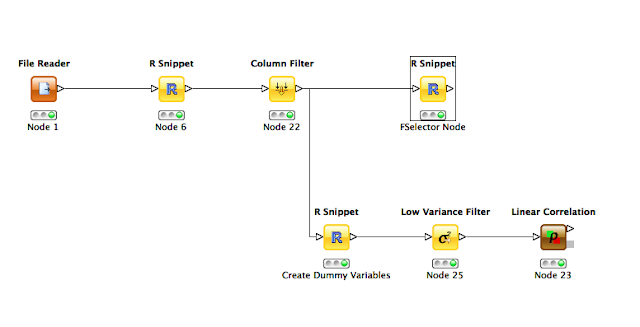
A third stream (not shown) sends the data to 3 machine-learning algorithms (namely an SVM, Decision Tree and Random Forest) and the Scorer shows how each algorithm performed.
I first executed the FSelector node using 10-fold cross-validation because I wanted to get a first feel of the features that are important in identifying some patterns about my perennial conjunctivitis. 7 out of 10 of FSelector algorithms agreed that
1) Vitamin D3
2) Garlic
3) Yoghurt
appear to have the most predictive power. The problem is that at this point we do not know if any of the features actually help or aggravate my condition. However, the output of FSelector gives an idea as to which features should be looked at more closely.
Then the second stream was run, the one that sends the data to three machine-learning algorithms so that I could get a first feel of how the algorithms perform. All three algorithms gave an F-Score of around 59 – 62%.
By looking at the results some patterns appeared to arise (note the word “appeared”):
1) A rather large daily dose (>5200 IU) of Vitamin D3 appears to be associated with smaller incidences of conjunctivitis.
2) Garlic consumption appears to increase my conjunctivitis incidences.
3) Yoghurt consumption appears to increase my conjunctivitis incidences.
For Pattern (1) we need to be aware that Vitamin D3 dosage has a compounding effect so it is rather naive to think that boolean logic applies (see previous post for more).
Next I had to look at patterns (2) and (3). One of the things that I realized when searching the web for the effect of various nutrients in functions of the human body is the fact that you can find for any several entries that sometimes contradict each other. My very brief web search has found garlic and yoghurt to be “immune boosters.” Of course caution should be exercised in drawing any conclusions because of the way the data have been collected and also the problematic origin of the analysis. Moreover, I am not a doctor and I cannot possibly know whether garlic or yoghurt can aggravate an immune response in such a way.
Although my bouts of conjunctivitis have ceased, I am not in any position to make any claims because there are a lot of uncontrolled variables:
– It could be a placebo effect.
– There may be unknown hidden variables that are important.
– Genetics.
– Environment.
– Variations in dosage and nutrient content.
– Interactions between nutrients.
There are lots of others that could not possibly be accounted for under these circumstances.
What I can say (and this is the reason for writing this post) is that analytics may help us to identify several patterns that may then be used to guide a sound knowledge discovery process. If people had the ability to collect data on a daily basis (see Quantified Self) and then analyze them on a massive scale, several unknown patterns that call for closer investigation could emerge.